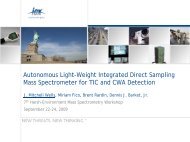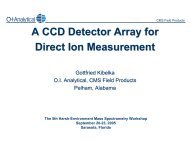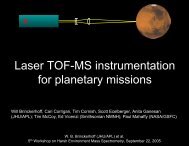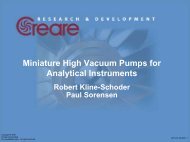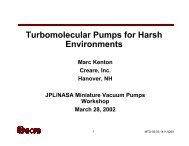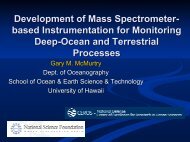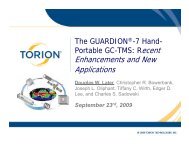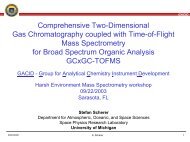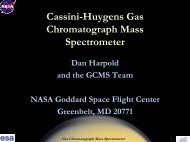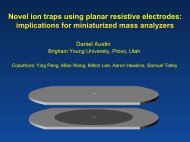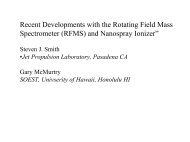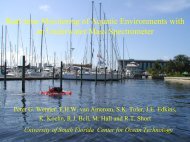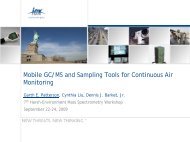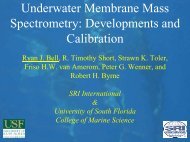Download the program .pdf - Harsh-Environment Mass Spectrometry
Download the program .pdf - Harsh-Environment Mass Spectrometry
Download the program .pdf - Harsh-Environment Mass Spectrometry
Create successful ePaper yourself
Turn your PDF publications into a flip-book with our unique Google optimized e-Paper software.
WELCOME<br />
On behalf of <strong>the</strong> Organizing Committee and HEMS Board, welcome to <strong>the</strong> 8 th Workshop on<br />
<strong>Harsh</strong> <strong>Environment</strong> <strong>Mass</strong> <strong>Spectrometry</strong> (HEMS).<br />
During this anniversary of <strong>the</strong> events on 9/11, in <strong>the</strong> wake of <strong>the</strong> Gulf Oil Spill, and recent<br />
natural disasters we are reminded of <strong>the</strong> eminent need to ruggedize and portabilize one of <strong>the</strong><br />
most versatile and sensitive chemical sensors of our day. We are all fortunate to be part of this<br />
active community, and I appreciate all <strong>the</strong> contributions of this group to take <strong>the</strong>se instruments<br />
well beyond <strong>the</strong> boundary of <strong>the</strong> lab. To places such as: battlefields, space, active volcanoes,<br />
below our seas, and often hazardous environments. This community has also led <strong>the</strong> way to<br />
novel front-end development, peripherals, and ruggedization techniques.<br />
The 8 th Workshop is a culmination of academics, government leaders, and industrial<br />
professionals brought toge<strong>the</strong>r by a common interest to forward progress for field mass<br />
spectrometry and ruggedization. Dissemination of individual group progress will be carried out<br />
in oral and poster formats. The well needed sponsorship and vendors will offer an opportunity<br />
to interact directly with <strong>the</strong> companies and groups with market products.<br />
The <strong>program</strong> will include time for discussion between presentations, as well as a social platform<br />
to meet and discuss projects and future directions for deployable mass spectrometry. Thank<br />
you for supporting HEMS and I look forward to <strong>the</strong> current presented research, and <strong>the</strong><br />
discussions for future directions.<br />
Sincerely,<br />
Guido F. Verbeck<br />
President HEMS<br />
Chairman, 8 th HEMS Workshop Organizing Committee<br />
STUDENT TRAVEL AWARD WINNERS:<br />
Josh S. Wiley, Purdue University, West Lafayette, IN<br />
Johannes Lang, Giessen University / GSI, Germany<br />
8 th HEMS Workshop<br />
Organizing Committee<br />
Guido Verbeck, Chairman<br />
Ben Gardener, Treasurer<br />
R. Timothy Short, Advisor<br />
Strawn Toler, Web/Materials<br />
Gottfried Kibelka , Student Scholarships<br />
Steve Taylor , Publications<br />
William Hoffmann, Program<br />
Barbara Walton, Program<br />
1<br />
<strong>Harsh</strong>-<strong>Environment</strong> <strong>Mass</strong><br />
<strong>Spectrometry</strong> Society Board<br />
Guido Verbeck, President<br />
Ben Gardener, Treasurer<br />
Strawn Toler, Secretary<br />
Directors without portfolio:<br />
Richard Arkin<br />
Gottfried Kibelka<br />
R. Timothy Short<br />
Steve Taylor<br />
James Wylde
Thank You to Our Sponsors<br />
2
Thank You to Our Sponsors<br />
3
History of <strong>the</strong> HEMS Workshop<br />
The <strong>Harsh</strong>-environment <strong>Mass</strong> <strong>Spectrometry</strong> (HEMS) Workshop was created in 1999 as a means<br />
of encouraging interaction among people involved in deploying mass spectrometers outside of<br />
<strong>the</strong> typical laboratory setting. These environments are diverse, ranging from volcanoes and<br />
battlefields, to ocean depths, outer space and o<strong>the</strong>r rugged locales. Building mass<br />
spectrometers to withstand <strong>the</strong> rigors of such harsh and remote environments places a unique<br />
burden on engineering design and science objective planning, where operational requirements<br />
for power, size, and durability must be met while achieving <strong>the</strong> goals of <strong>the</strong> scientific mission.<br />
We hope to foster and promote interaction between scientists and engineers through <strong>the</strong><br />
informal setting of <strong>the</strong> HEMS Workshop and thus stimulate <strong>the</strong> development of HEMS<br />
technology and applications.<br />
Previous Workshops<br />
1 st Workshop on <strong>Harsh</strong> <strong>Environment</strong> <strong>Mass</strong> Spectrometers<br />
February 21-23, 1999; St. Petersburg, Florida<br />
Sponsored by <strong>the</strong> University of South Florida, Marine Science Department, Center for Ocean<br />
Technology<br />
2 nd Workshop on <strong>Harsh</strong> <strong>Environment</strong> <strong>Mass</strong> <strong>Spectrometry</strong><br />
March 18-21, 2001; St. Petersburg, Florida<br />
Presented by <strong>the</strong> University of South Florida, Marine Science Department, Center for Ocean<br />
Technology<br />
The 3 rd <strong>Harsh</strong>-<strong>Environment</strong> <strong>Mass</strong> <strong>Spectrometry</strong> Workshop &<br />
The 2 nd NASA/JPL Miniature vacuum Pumps Workshop<br />
March 25-28, 2002; Pasadena, California<br />
Presented by <strong>the</strong> Jet Propulsion Laboratory/NASA<br />
The 4 th <strong>Harsh</strong>-<strong>Environment</strong> <strong>Mass</strong> <strong>Spectrometry</strong> Workshop<br />
October 7-10, 2003; St. Petersburg, Florida<br />
Presented by <strong>the</strong> Center for Ocean Technology, University of South Florida College of Marine<br />
Science<br />
The 5 th <strong>Harsh</strong>-<strong>Environment</strong> <strong>Mass</strong> <strong>Spectrometry</strong> Work shop<br />
September 20-23, 2005; Lido Beach, Sarasota, Florida<br />
Presented by <strong>the</strong> Center for Ocean technology, University of South Florida College of Marine<br />
Science<br />
4
The 6 th <strong>Harsh</strong>-<strong>Environment</strong> <strong>Mass</strong> <strong>Spectrometry</strong> Workshop<br />
September 17,20, 2007; Cocoa Beach, Florida<br />
Presented by <strong>the</strong> ASRC Aerospace Corporation, Kennedy Space Center<br />
The 7 th <strong>Harsh</strong>-<strong>Environment</strong> <strong>Mass</strong> <strong>Spectrometry</strong> Workshop<br />
September 21-24,2009; Santa Barbara, California<br />
Presented by <strong>the</strong> Hamilton Sunstrand Corporation<br />
The 8 th <strong>Harsh</strong>-<strong>Environment</strong> <strong>Mass</strong> <strong>Spectrometry</strong> Workshop<br />
September 19, 21, 2011; St. Pete Beach, Florida<br />
Presented by <strong>the</strong> University of North Texas<br />
For <strong>program</strong>s, proceedings, and participants please visit:<br />
http://www.hems-workshop.org/Archive.html<br />
5
Opening Talk: Kevin Lothridge, Chief Executive Officer – NFSTC’s principal investigator<br />
Mr. Lothridge is an accomplished forensic scientist with 17 years of operational<br />
experience, having held positions as a forensic chemist, chief forensic chemist, and laboratory<br />
director for <strong>the</strong> Pinellas County Sheriff’s Department and <strong>the</strong> Pinellas County Forensic<br />
Laboratory. In 2006–07, he led <strong>the</strong> development of <strong>the</strong> Deployable Forensic Laboratory project<br />
for <strong>the</strong> Department of Defense. Because of his expertise, Mr. Lothridge has testified in court<br />
more than 50 times as an expert in controlled substances and fire debris analysis. He also<br />
speaks at numerous professional conferences, and he co-authored <strong>the</strong> GC-MS Guide to<br />
Ignitable Liquids.<br />
Mr. Lothridge holds a bachelor’s degree in Forensic Science from Eastern Kentucky<br />
University and a master’s degree in Management from National-Louis University. He has served<br />
as president of <strong>the</strong> American Society of Crime Laboratory Directors (ASCLD) and as acting chief<br />
of <strong>the</strong> Investigative and Forensic division of <strong>the</strong> National Institute of Justice (NIJ). In his role as<br />
CEO of NFSTC, he provides leadership, direction and vision for <strong>the</strong> organization.<br />
The National Forensic Science Technology Center (NFSTC)<br />
The National Forensic Science Technology Center (NFSTC) is a 501(c)(3) not-for-profit<br />
corporation headquartered in Largo, Florida. Founded in 1995, <strong>the</strong> NFSTC provides quality<br />
forensic services including training, assessment, technology evaluation and assistance to <strong>the</strong><br />
justice and forensic communities. NFSTC receives funding from <strong>the</strong> National Institute of Justice<br />
and o<strong>the</strong>r federal agencies. NFSTC founded and maintains NIJ’s Forensic Technology Center of<br />
Excellence and <strong>the</strong> National Missing and Unidentified Persons System (NamUs).<br />
www.nfstc.org<br />
6
Monday, September 19<br />
Time Topic Speaker Page #<br />
7:00 pm Registration<br />
Meet & Greet (Light Refreshments will be available 7-9pm)<br />
(See Page 13 for Floor Plans of Don CeSar)<br />
7
Tuesday, September 20<br />
Time Topic Speaker Page #<br />
7:00 Breakfast<br />
8:40 Welcoming Remarks G. Verbeck<br />
9:00 Opening Talk: Traditional Tools in Non-Traditional<br />
<strong>Environment</strong>s: Forensic Science in <strong>the</strong> Field<br />
K. Lothridge 14<br />
9:30 Underwater Cryotrap - Membrane Inlet System<br />
T. Gentz 15<br />
(CT-MIS) for Improved in situ Analysis of Gases by<br />
<strong>Mass</strong> <strong>Spectrometry</strong><br />
10:00 Mid-Morning Break<br />
10:30 Underwater Membrane Introduction <strong>Mass</strong><br />
R.T. Short 16<br />
Spectrometers: Recent Developments and<br />
Deployments<br />
11:00 Modular Quantitative Air Sampling for Field<br />
P. Smith 17<br />
Analysis using Person-Portable GC-MS<br />
11:30 A Suite of Sampling Aids for <strong>the</strong> In-Field SPME<br />
S.A. Lammert 18<br />
Collection of Analytes from Air, Particulates, and<br />
Surfaces<br />
12:00 Lunch on your own<br />
1:30 The Sample Analysis at Mars (SAM): Developing<br />
D. Harpold 19<br />
Analytical Tools to Search for a Habitable<br />
<strong>Environment</strong> on Mars<br />
2:00 Applications of Field-Mobile Purge and Trap<br />
G. Patterson 20<br />
GC/MS for Onsite Water Analysis<br />
2:30 Oil-in-Water Monitoring in <strong>the</strong> North Sea using<br />
B. Brkic 21<br />
Membrane Inlet <strong>Mass</strong> <strong>Spectrometry</strong><br />
3:00 On-site Analysis of <strong>Environment</strong>al Air and Water<br />
Samples at a SAGD Oil Production Facility (Statoil)<br />
in Nor<strong>the</strong>rn Alberta using MIMS<br />
R. Bell 22<br />
3:30 Magnet Portable <strong>Mass</strong> Spectrometer for Direct A. Antonov 23<br />
Control of Gases in Sea Water<br />
4:00 Poster Session See Abstracts 40-52<br />
(Light Refreshments will be available during poster session)<br />
Evening Free<br />
8
Wednesday, September 21<br />
Time Topic Speaker Page #<br />
7:00 Breakfast<br />
8:15 Announcements<br />
8:30 Mobile High-Resolution Multiple-Reflection Timeof-Flight<br />
J.Lang<br />
24<br />
<strong>Mass</strong> Spectrometer for in-situ Analytics Student Award Winner<br />
9:00 New Person Portable Gas Chromatograph for<br />
C.S. Sadowski 25<br />
<strong>Harsh</strong> <strong>Environment</strong>s – Design Criteria, and<br />
Verification Testing<br />
9:30 Development of a Miniature Rectilinear Ion Trap P. Hendricks 26<br />
Array with Independently Controlled Channels<br />
10:00 Group/Photo & Mid-Morning Break<br />
10:30 Redesign of <strong>the</strong> VAPoR Miniaturized Pyrolysis<br />
A.E. Southard 27<br />
TOFMS for Improved Sensitivity<br />
11:00 Recent Advances in Portable <strong>Mass</strong> <strong>Spectrometry</strong><br />
C.R. Arkin 28<br />
Systems at Kennedy Space Center<br />
11:30 Cylindrical Toroidal Ion Trap <strong>Mass</strong> Spectrometer D. Austin 29<br />
12:00 Lunch on your own<br />
1:30 Design and Use of Portable and Compact<br />
K. Wright 30<br />
Sampling Systems for <strong>Mass</strong> Spectrometers<br />
2:00 Design of Pocket <strong>Mass</strong> Spectrometer in a Mobile<br />
M. Yang 31<br />
Phone Size<br />
2:30 Mid-Afternoon Break<br />
3:00 A Completely Handheld Ambient Ionization<br />
J.S. Wiley<br />
32<br />
Source for <strong>Mass</strong> <strong>Spectrometry</strong> Based on a Low- Student Award Winner<br />
Temperature Plasma (LTP)<br />
3:30 A Miniaturized Laser-Ablation <strong>Mass</strong><br />
A. Riedo 33<br />
Spectrometer Designed for in-situ Measurements<br />
on Planetary Space Missions<br />
4:00 Autoresonant Ion Trap <strong>Mass</strong> <strong>Spectrometry</strong><br />
G.A. Brucker 34<br />
(ART MS)<br />
6:30 Workshop Dinner at The Don CeSar<br />
9
Thursday, September 22<br />
Time Topic Speaker Page #<br />
7:00 Breakfast<br />
8:15 Announcements<br />
8:30 Negative Ions for Fieldable <strong>Mass</strong> <strong>Spectrometry</strong> W.B. Whitten 35<br />
9:00 Mobile <strong>Mass</strong> Spectrometer in Daily Use –<br />
F. Lange 36<br />
Experiences Made by Non-Scientific Operators<br />
9:30 Utilization of Lightweight MS based<br />
J.A. Diaz 37<br />
Instrumentation and Small UAV Platforms for In-<br />
Situ Volcanic Plume Analysis<br />
10:00 Mid-Morning Break<br />
10:30 A Transportable FTICR/MS for Direct and Real-<br />
E.Louarn 38<br />
Time Analysis of VOC Contaminants in Air and<br />
Water<br />
11:00 Low Power Atmospheric Gas Sampling System<br />
G.A. Brucker 39<br />
Based on ART MS Sensor and NEG-Ion Pump<br />
System<br />
11:30 Program Survey and Closing<br />
10
The Don CeSar Beach Resort:<br />
Opened in 1928 by Thomas Rowe, <strong>the</strong> "Pink Lady" or Don Ce-Sar, quickly became a hot spot for <strong>the</strong> rich<br />
and famous during <strong>the</strong> Jazz Age. Patrons included, Clarence Darrow, F. Scott Fitzgerald, Lou Gehrig,<br />
Franklin D. Roosevelt, and Al Capone. The New York Yankees called this place home during spring<br />
training for three years during <strong>the</strong> Great Depression. In December 1942, <strong>the</strong> hotel was reopened as a<br />
military hospital, and in 1945 it was converted again into a Veterans Administration Regional Office.<br />
Almost 30 years later, <strong>the</strong> hotel was bought by a Holiday Inn franchise owner and reopened in 1973 as<br />
The Don CeSar. It was named to <strong>the</strong> National Register of Historic Places in 1975, and has been <strong>the</strong> film<br />
site for movies (Once Upon a Time in America and Thunder in Paradise), music videos (Tom Petty and<br />
<strong>the</strong> Heartbreakers), and provided material for comedian Ron White as he talk about his stay at <strong>the</strong> Don<br />
CeSar in Blue Collar Comedy Tour: One for <strong>the</strong> Road.<br />
The wireless network that will be available for conference use in <strong>the</strong> meeting<br />
rooms is named "SWANK" and no password is required.<br />
St. Pete Beach, Florida<br />
Restaurants:<br />
http://www.stpetebeach.com/restaurants<br />
-Frenchy's Seafood<br />
-Woody's Waterfront<br />
-PJ's Oyster Bar<br />
-The Lobby-Downtown's Martini Bar<br />
Attractions:<br />
http://www.stpetebeach.com/attractions<br />
-Armed Forces Museum<br />
-The Florida Aquarium<br />
-Ruth Eckerd Hall<br />
11
Directions and Map<br />
From:<br />
Tampa International Airport (TPA)<br />
4424 N West Shore Blvd.<br />
Tampa, FL 33614<br />
To:<br />
Don CeSar Beach Resort<br />
3400 Gulf Blvd.<br />
St. Pete Beach, FL 33706<br />
**Please be advised, <strong>the</strong>re is a $.50 toll between <strong>the</strong> airport<br />
and <strong>the</strong> Don CeSar**<br />
12
Meeting Locations in Don CeSar<br />
13
Oral Abstract<br />
Traditional Tools in Non-Traditional <strong>Environment</strong>s:<br />
Forensic Science in <strong>the</strong> Field<br />
K. LOTHRIDGE<br />
The National Forensic Science Technology Center (NFSTC)<br />
Forensic science training for soldiers in <strong>the</strong>ater continues to grow in importance and timeliness, but<br />
most soldiers don’t have a PhD in chemistry, never mind a background that includes scientific training.<br />
How do we take <strong>the</strong> best chemical identification tools and put <strong>the</strong>m in <strong>the</strong> hands of <strong>the</strong> best warfighters<br />
to save lives and ga<strong>the</strong>r critical data? NFSTC regularly trains special operations soldiers to do just that<br />
by streamlining training on applied chemical detection and mass spectrometry specifically for harsh and<br />
remote environments. By providing simplified job aids and hands on practice for detection,<br />
maintenance and reach back, trained soldiers can acquire a high degree of competence in a short time.<br />
NFSTC routinely looks for and evaluates tools that can be applied in varied environments consistent<br />
results. This presentation will cover techniques used to train soldiers and o<strong>the</strong>r non-scientists such as<br />
law enforcement officers, and share some of <strong>the</strong> outcomes from this work.<br />
14
Oral Abstract<br />
Underwater cryotrap - membrane inlet system (CT-<br />
MIS) for improved in situ analysis of gases by mass<br />
spectrometry<br />
T. GENTZ & M. SCHLÜTER<br />
Alfred-Wegener-Institute for Polar and Marine Research, Bremerhaven, Germany<br />
Membrane inlet mass spectrometer (MIMS) allows online, real time, onsite and simultaneous analysis of<br />
trace gases during investigations of terrestrial as well as aquatic environments. For applied as well as<br />
pure research investigations of gases like methane, higher hydrocarbons or CO 2 are of specific interest.<br />
The large quantity of water vapor passing <strong>the</strong> membrane inlet downgrades <strong>the</strong> detection limit, affects<br />
<strong>the</strong> ionization efficiency, or could cause condensation of water within <strong>the</strong> sensor section. These effects<br />
can be reduced by application of cryotraps. Whereas a wide range of cryotraps are available for<br />
application in <strong>the</strong> laboratory, for field measurements or deployments of underwater mass<br />
spectrometers <strong>the</strong>re seems to be still a demand for compact and robust cryotrap systems. Required<br />
features of such a system are a small size and weight as well as energy consumption below 10 Watt.<br />
Especially for application of underwater mass spectrometers (UWMS), we designed a cryotrap system<br />
that reduces <strong>the</strong> water vapor in <strong>the</strong> analytical line significantly and build a security system to protect <strong>the</strong><br />
sensor unit in case of membrane rupture. The in situ cryotrap is a robust system within a self-contained<br />
pressure housing and is operated at -85°C.<br />
We present <strong>the</strong> results of <strong>the</strong> assessment of <strong>the</strong> systems, in terms of <strong>the</strong> waste heat to cope with, <strong>the</strong><br />
efficiency to trap water vapor, as well as side effects caused by trapping gases to be analyzed.<br />
Improvements of detection limits as well as signal stability are discussed. Fur<strong>the</strong>rmore <strong>the</strong> design of <strong>the</strong><br />
MIS is considered. Beside <strong>the</strong> system assessment, field results derived by <strong>the</strong> underwater cryotrap<br />
system coupled to <strong>the</strong> UWMS InSpectr200-200 are presented.<br />
15
Underwater Membrane Introduction <strong>Mass</strong><br />
Spectrometers: Recent Developments and<br />
Deployments<br />
Oral Abstract<br />
R.T. SHORT 1 , S.K. TOLER 1 , R.J. BELL 1 , and R.H. BYRNE 2<br />
1 SRI International<br />
2 University of South Florida<br />
The need for chemical monitoring and profiling in our oceans is driven by basic scientific questions as<br />
well as more pressing considerations such as <strong>the</strong> recent Deepwater Horizon oil spill. Versatile in situ<br />
analyzers are needed to locate, map, and monitor <strong>the</strong> long-term fate of chemical compounds. In situ<br />
mass spectrometers fill this need with capabilities that far exceed traditional underwater chemical<br />
sensing techniques with respect to dynamic range, and to sensitivity and selectively to a broad range of<br />
analytes. SRI International’s in situ membrane introduction mass spectrometry (MIMS) instruments can<br />
quantitatively detect volatile organic compounds in water at trace levels, while simultaneously<br />
monitoring <strong>the</strong> concentrations of all light, stable dissolved gases to a depth of 1500 meters. Recent<br />
deployments of <strong>the</strong> UMS systems in <strong>the</strong> Santa Barbara Channel and <strong>the</strong> Gulf of Mexico will be discussed.<br />
In addition, <strong>the</strong> ever-growing concerns regarding global warming and ocean acidification have led to a<br />
significant interest in developing in situ methods to characterize <strong>the</strong> oceanic carbon system. Toward this<br />
goal, we will present a novel method to simultaneously determine <strong>the</strong> partial pressure of carbon dioxide<br />
(pCO 2 ) and total dissolved inorganic carbon (DIC) in seawater using MIMS.<br />
16
Oral Abstract<br />
Modular Quantitative Air Sampling for Field Analysis<br />
using Person-Portable GC-MS<br />
P. SMITH , S. STRATING, D. WHITE<br />
U.S. Department of Labor – OSHA, Health Response Team; Uniformed Services University of <strong>the</strong> Health<br />
Sciences, Department of Preventive Medicine and Biometrics; Uniformed Services University of <strong>the</strong><br />
Health Sciences, Department of Preventive Medicine and Biometrics<br />
Thermal desorption is well suited for <strong>the</strong> introduction of analytes trapped on sorbent for quantitative<br />
analysis using gas chromatography-mass spectrometry (GC-MS). A traditional approach for <strong>the</strong>rmal<br />
desorption with laboratory GC-MS analysis involves heating a packed tube containing several hundred<br />
milligrams of sorbent, and requires primary desorption flow much greater than that of carrier gas<br />
through a capillary GC column. Preconcentration on a very small volume of sorbent is thus required<br />
before <strong>the</strong> desorbed analytes may be introduced into <strong>the</strong> GC inlet to match <strong>the</strong> flow through <strong>the</strong> GC<br />
column, and heated transfer lines and bulky <strong>the</strong>rmal desorption equipment are typically used. We<br />
report <strong>the</strong> use of a small diameter needle packed with sorbent as a preconcentrator to accept analytes<br />
from a traditional <strong>the</strong>rmal desorption tube using a compact transfer heater separate from <strong>the</strong> analytical<br />
instrument. Controlled carrier gas flow through <strong>the</strong> needle trap that matches <strong>the</strong> GC column<br />
requirements, and simultaneous heating in <strong>the</strong> small GC injector of <strong>the</strong> person-portable GC-MS<br />
instrument used allowed quantitative analyte introduction without <strong>the</strong> need for split injection. Analytes<br />
ranging from toluene to tributyl phosphate produced a linear response from <strong>the</strong> instrument's toroidal<br />
ion trap mass spectrometric detector when about 10 to 100 ng of each was desorbed from a large<br />
sorbent tube onto <strong>the</strong> needle trap for introduction into <strong>the</strong> person-portable instrument. This<br />
corresponded to airborne concentrations in <strong>the</strong> single digit ppb range with a five minute sample time at<br />
an air sampling rate of 100 mL/minute through <strong>the</strong> large sorbent tube. A combined sampling and<br />
analysis time of 15 minutes is possible using this approach, without <strong>the</strong> need to alter <strong>the</strong> personportable<br />
GC-MS instrument or to reduce <strong>the</strong> ability to move <strong>the</strong> instrument that would result from <strong>the</strong><br />
use of a typical <strong>the</strong>rmal desorption apparatus.<br />
17
Oral Abstract<br />
A Suite of Sampling Aids for <strong>the</strong> In-Field SPME<br />
Collection of Analytes from Air, Particulates, and<br />
Surfaces<br />
S.A. LAMMERT 1 , G.S. GROENEWOLD 2 , J.R. SCOTT 2 , D. LI 3 , J.L. OLIPHANT 1 , T.V. TRUONG 1 , N.L. PORTER 1<br />
1 Torion Technologies, Inc.<br />
2 Idaho National Laboratory<br />
3 Brigham Young University<br />
Earlier this year, Torion Technologies introduced an improved version of its GUARDION®-7 field portable<br />
GC-TMS system. The system (marketed as <strong>the</strong> TRIDONTM-9 by Torion and as <strong>the</strong> GUARDION® by Smiths<br />
Detection) has improved analytical performance along with increased ruggedness. Like its predecessor,<br />
<strong>the</strong> new system continues to take advantage of SPME sampling and sample introduction. Concurrent<br />
with <strong>the</strong> development of this next-generation GC-TMS, has been <strong>the</strong> development of a suite of sampling<br />
technologies that can assist in acquiring samples from air, liquids, and surfaces while employing SPME<br />
sampling technology. For each type of sample, new strategies to improve <strong>the</strong> extraction and collection<br />
of targeted compounds. In one case, a portable field vacuum extractor (FVE), developed at Idaho<br />
National Laboratory and under prototype hardware development at Torion allows increased sampling<br />
efficiency for <strong>the</strong> SPME collection of semivolatile samples from surfaces by providing a low vacuum<br />
environment over <strong>the</strong> surface during sampling by <strong>the</strong> SPME fiber. Increased sample collection results in<br />
shorter sampling times using this approach as demonstrated for several Chemical Warfare Agent (CWA)<br />
simulants. To support in-field calibration and quantitation applications, a constant headspace<br />
concentration calibration vial has been developed. This approach encapsulates <strong>the</strong> desired calibrants in<br />
cross-linked, micro-ground PDMS particles, which for a given temperature, bleed into <strong>the</strong> headspace at<br />
a constant level allowing hundreds of quantitative samples to be acquired. For <strong>the</strong> detection of<br />
biological threats, a prototype, portable, and automated chemical processing unit designed to liberate<br />
unique, small molecule biomarkers from bacteria (at this stage, Bacillus anthrasis spores have been<br />
targeted). These small molecule biomarkers are <strong>the</strong>n sampled onto a SPME fiber, which is subsequently<br />
analyzed by GC/MS. Finally, a small-format, in-needle sample concentrator housed in <strong>the</strong> same form<br />
factor and dimensions as <strong>the</strong> SPME needle is under development for <strong>the</strong> concentration of trace<br />
analytes.<br />
18
Oral Abstract<br />
The Sample Analysis at Mars (SAM): Developing<br />
Analytical Tools to Search for a Habitable<br />
<strong>Environment</strong> on Mars<br />
D. HARPOLD<br />
NASA/GSFC, Greenbelt, MD<br />
NASA’s next exploration mission to <strong>the</strong> surface of Mars, <strong>the</strong> Mars Science Laboratory (MSL), is scheduled<br />
to be launched in late November 2011 and will land on <strong>the</strong> Mars surface in August 2012. MSL’s rover,<br />
named Curiosity, will operate on Mars for at least one Mars year (approximately two Earth years) and<br />
explore and quantitatively assess <strong>the</strong> habitability of <strong>the</strong> region by measuring any complex organic<br />
molecules as well as isotopic composition of inorganic and organic carbon that may be present in rocks<br />
and soils. One of <strong>the</strong> scientific instruments on board Curiosity is <strong>the</strong> Sample Analysis at Mars (SAM)<br />
instrument suite consisting of a Quadrupole <strong>Mass</strong> Spectrometer (QMS), a Gas Chromatograph (GC) and<br />
a Tunable Laser Spectrometer (TLS). The QMS and GC can operated toge<strong>the</strong>r in a GCMS mode. The TLS<br />
obtains precise isotope ratios for C and O in carbon dioxide and measures trace levels of methane and<br />
its carbon isotopes. This presentation will focus on some of <strong>the</strong> engineering challenges facing <strong>the</strong> SAM<br />
team during <strong>the</strong> development stages and thru <strong>the</strong> integration and delivery of <strong>the</strong> suite to <strong>the</strong> Rover.<br />
19
Oral Abstract<br />
Applications of Field-Mobile Purge and Trap GC/MS<br />
for Onsite Water Analysis<br />
G. PATTERSON, C. LIU, M. WELLS, D.J. BARKET<br />
FLIR <strong>Mass</strong> <strong>Spectrometry</strong> (Griffin), West Lafayette, IN<br />
There is an increasing interest from certain sectors of analytical chemistry, including <strong>the</strong> environmental<br />
and forensic analysis communities, for instrumentation that can make measurements on-site, at <strong>the</strong><br />
point where <strong>the</strong> samples are collected. On-site analysis can save time and money, preserve valuable<br />
chemical information, and provide immediate information in critical situations. Water samples in<br />
particular are of importance in environmental applications, and can benefit significantly from immediate<br />
on-site analysis. A simplified, ruggedized purge and trap module that directly interfaces with a mobile<br />
GC/MS has been tested to determine its capability for analyzing organic pollutants in water.<br />
The ruggedized purge and trap module was interfaced to a Griffin 460 mobile GC/MS system through<br />
<strong>the</strong> Universal Sampling Port, which is included on that instrument for interfacing various sampling<br />
accessories. The purge and trap was designed to mate directly to <strong>the</strong> port for both gas and electrical<br />
connections. Methods were developed using specific purge and trap control software written into <strong>the</strong><br />
Griffin System Software package. Purge and trap parameters including purge flow, purge time, and GC<br />
temperature <strong>program</strong> were all optimized for <strong>the</strong> individual analyses described below. Samples were<br />
prepared via dilution into distilled water from analytical standards generally acquired from Aldrich and<br />
Accustandard. The purge and trap module was tested against a variety of relevant organic samples in<br />
water, including VOCs and disinfection by-products in drinking water from various sources.<br />
20
Oil-in-Water Monitoring in <strong>the</strong> North Sea using<br />
Membrane Inlet <strong>Mass</strong> <strong>Spectrometry</strong><br />
Oral Abstract<br />
B.BRKIC, N.FRANCE, J.SREEKUMAR, K.THABETH AND S.TAYLOR<br />
University of Liverpool and Advanced Sensors Ltd, Liverpool, UK.<br />
A membrane inlet mass spectrometry (MIMS) system has been used for detection and analysis of two<br />
types of North Sea crude oil. The system was installed on-field on <strong>the</strong> Flotta Oil Terminal (Orkney, UK). It<br />
consisted of a quadrupole mass spectrometer (QMS) connected to <strong>the</strong> capillary probe with a siliconebased<br />
membrane. The produced mass spectra and calibration plots from <strong>the</strong> MIMS instrument showed<br />
capability to measure levels of individual hydrocarbons within crude oil in sea water. The generated<br />
mass spectra from <strong>the</strong> field tests also showed ability to distinguish between different types of oil and<br />
determining concentrations of toxic hydrocarbons in oil (e.g. benzene, toluene and xylene (BTX)). The<br />
performance of <strong>the</strong> instrument at different temperatures of sea water and oil droplet sizes was also<br />
investigated. The results showed that QMS-based MIMS system has a potential to complement existing<br />
oil-in-water (OiW) monitors by being able to detect different oil types and specific hydrocarbon<br />
concentrations with high accuracy, which are currently not supported in commercially available OiW<br />
monitors.<br />
21
Oral Abstract<br />
On-site Analysis of <strong>Environment</strong>al Air and Water<br />
Samples at a SAGD Oil Production Facility (Statoil) in<br />
Nor<strong>the</strong>rn Alberta using MIMS<br />
1 R. BELL, 1 N. DAVEY, 1 E. KROGH, 1 C. GILL, 2 M. MARTINSEN, 2 O. MIKKELSEN, 2 R. SCHMID, 3 C. COLLIN-<br />
HANSEN<br />
1 Vancouver Island University, Nanaimo, BC<br />
2 NTNU<br />
3 Statoil, TNE RD, Alberta<br />
A portable ion trap (Griffin 400) was modified to include a He flushed membrane interface. The<br />
membrane introduction mass spectrometer (MIMS) was plumbed to enable <strong>the</strong> analysis of both<br />
aqueous and gaseous analytes. Lead acid batteries provided over 10 hours of daily field portability for<br />
real-time, on-site analysis of environmental samples in Nor<strong>the</strong>rn Alberta’s oil sands. Data were primarily<br />
collected at Statoil’s Leismer SAGD (Steam Assisted Gravity Drainage) site in June 2010 and Sept 2010<br />
prior to oil production, and June 2011 just after <strong>the</strong> site’s 1 millionth barrel of oil was produced. For<br />
comparative purposes, data were collected at water bodies and air sampling locations adjacent to<br />
various surface mining facilities operating near Fort McMurray, Alberta. Both single point (from grab<br />
samples) and timeseries data sets were produced. Fur<strong>the</strong>r, samples of bitumen, steam condensate, and<br />
o<strong>the</strong>r SAGD reagents were collected from <strong>the</strong> Leismer production facility for lab analysis. Gaseous<br />
samples were infused with deuterated toluene (toluene-D8) via a <strong>the</strong>rmally regulated permeation tube.<br />
The toluene-d8 signal acts as an internal standard enabling <strong>the</strong> operator to monitor instrumental<br />
artifacts that may affect signal intensity. MIMS data were correlated with meteorological and positional<br />
data and used to produce data analysis products using a Google Earth interface.<br />
22
Oral Abstract<br />
Magnet Portable <strong>Mass</strong> Spectrometer for Direct<br />
Control of Gases in Sea Water<br />
A. ANTONOV, V. KOGAN, D. LEBEDEV, A. PAVLOV, Y. CHICHAGOV, S. VLASOV<br />
A.F. Ioffe Physical Technical Institute, Academy of Science, St. Petersburg, Russia<br />
Portable automated magnet mass spectrometer with membrane inlet system for direct control of<br />
alkanes (C1-C5) and air constituents in seawater surface layers were considered. Characteristics,<br />
structure, main units and operating modes of <strong>the</strong> instrument were described. The dynamic peculiarities<br />
of <strong>the</strong> instrument response on target compound introduction were determined and taken into account<br />
at operating modes optimization. The results of testing of <strong>the</strong> direct mass spectrometric determination<br />
of air constituents, methane, ethane, propane, isobutene and pentane in water samples for fitful and<br />
permanent operating modes were discussed.<br />
23
Oral Abstract<br />
Mobile High-Resolution Multiple-Reflection Timeof-Flight<br />
<strong>Mass</strong> Spectrometer for in-situ Analytics<br />
Student Abstract Award Winner<br />
J.LANG, W.R.PLAß, T.DICKEL, J.EBERT, H.GEISSEL, M.YAVOR, C.SCHEIDENBERGER<br />
Giessen University / GSI, Germany<br />
Many mass spectrometric methods, such as de-novo sequencing, require high mass resolving power and<br />
accuracy to determine unambiguously <strong>the</strong> composition and structure of molecules. Until now, mass<br />
spectrometers for <strong>the</strong>se applications are ra<strong>the</strong>r large and immobile.<br />
In this contribution a novel and mobile multiple-reflection time-of-flight mass spectrometer (MR-TOF-<br />
MS) will be presented. It will achieve a high mass resolving power exceeding 100000 and sub ppm<br />
accuracy in a compact design. Due to short cycle time (compared to FT-ICR and Orbitrap MS) vacuum<br />
requirements are ra<strong>the</strong>r moderate and <strong>the</strong> measurement rate up to 1kHz provides GC/MS compatibility.<br />
There is no fundamental upper mass limit and a large duty cycle allows for high efficiency. Its<br />
compactness and robust concept favors in-situ analytics at any place, even in an rough environment.<br />
Mechanical stability has been carefully considered to obtain a rugged setup in every component. An<br />
atmospheric pressure interface (API) for atmospheric ionization techniques (DESI, ESI, REIMS) makes it<br />
versatile and opens various fields of application. Besides <strong>the</strong> API <strong>the</strong> MR-TOF-MS consists of an RFQ<br />
cooler, RF ion trap, time-of-flight analyzer, MCP detector and DAQ. Vacuum system components, power<br />
supplies as well as electronics are mounted toge<strong>the</strong>r with <strong>the</strong> ion optical mass spectrometer parts in a<br />
single frame. The system has been built and is currently being commissioned.<br />
Projected applications include in-situ mass spectrometry such as realtime tissue recognition in<br />
electrosurgery, identification of mycotoxins and analysis of soil samples for environmental studies. This<br />
unique combination of high mass resolving power and accuracy, compactness, robustness and mobility<br />
perfectly qualifies for use in harsh environment, future space missions or airborne climate<br />
investigations.<br />
24
Oral Abstract<br />
New Person Portable Gas Chromatograph for <strong>Harsh</strong><br />
<strong>Environment</strong>s – Design Criteria, and Verification<br />
Testing<br />
C.S. SADOWSKI 1 , J.L. JONES 1 , E.D. LEE 1 , E.G. DIKEN 2 , and D.D. MANNING 2<br />
1 Torion Technologies, American Fork, UT<br />
2 Smiths Detection, Danbury, CT<br />
Torion Technologies and Smiths Detection have developed, designed and fielded <strong>the</strong> next generation<br />
field portable gas chromatograph–mass spectrometers (GC-MS). Based on <strong>the</strong> Toroidal MS technology<br />
employed in <strong>the</strong> Torion GUARDION®-7, <strong>the</strong> new instrument has been designed for use in harsh<br />
environments, improving <strong>the</strong> performance, operational simplicity and expanding <strong>the</strong> applications. The<br />
GC-TMS system is capable of operating in temperatures ranging from zero to 45oC and has been sealed<br />
for use in chemically contaminated environments. The system has been ruggedized to withstand<br />
transport, handling and for use in harsh environments, illustrated, for example, by operation at drill rig<br />
sites, rapid environmental site assessment at hazardous waste sites, and use by deployed troops and<br />
first responders. Meeting <strong>the</strong> challenges of size and weight reduction, while maintaining operational<br />
capabilities and improving performance, required detailed attention to all aspects of <strong>the</strong> design.<br />
Managing internal temperatures and meeting <strong>the</strong> design criteria for size and weight were <strong>the</strong> prime<br />
challenges faced during <strong>the</strong> design process.<br />
The use of computer aided design tools for heat management and ruggidization provided for rapid<br />
simulations that helped guide <strong>the</strong> design process. Verification that design criteria were met required<br />
that extensive testing be performed. Test criteria and results for <strong>the</strong> following will be discussed in this<br />
presentation:<br />
1. <strong>Environment</strong>al<br />
a. Temperature - operational and storage<br />
b. Humidity and rain<br />
c. Sand and dust<br />
2. Physical<br />
a. Shock and vibration<br />
b. Chemical contamination and decontamination<br />
3. Performance<br />
a. Gas chromatograph<br />
b. <strong>Mass</strong> analyzer<br />
c. Total System<br />
25
Oral Abstract<br />
Development of a Miniature Rectilinear Ion Trap<br />
Array with Independently Controlled Channels<br />
1 P. HENDRICKS, 2 J.D. MAAS, 2 W.J. CHAPPELL, 1 R.J. NOLL, 3 Z. OUYANG, 1 R.G. COOKS<br />
1 Purdue University, Department of Chemistry, West Lafayette, IN<br />
2 Purdue University, Department of Electrical Engineering, West Lafayette, IN<br />
3 Purdue University, Department of Biomedical Engineering, West Lafayette, IN<br />
An eight-channel array of miniaturized rectilinear ion traps (RIT) with electrically isolated electrodes has<br />
been constructed using stereolithography (SLA) technology. The trapping dimensions for each channel<br />
measure 1.66 x 1.33 x 16.66 mm, X0, Y0, and Z respectively, and are arranged in a circular pattern<br />
around a single central detector. The array is metal plated through uniform electroless Cu deposition,<br />
and <strong>the</strong>n subject to metal ablation using a high aspect ratio laser for electrical isolation of each<br />
electrode. Using bias tee networks and dedicated operational amplifiers individual ion trap control can<br />
be used to improve <strong>the</strong> overall spectral quality of <strong>the</strong> device by compensating for dimensional variation<br />
of between ion trap channels. The device is operated using a discontinuous atmospheric pressure<br />
interface (DAPI) for direct sampling of externally generated ions <strong>the</strong>refore operated at pressures of ~10-<br />
1 to ~10-2 Torr during sample introduction and at <strong>the</strong> start of mass analysis. Single channel performance<br />
for mass spectral resolution is approximately 1 to 2 Th FWHM across <strong>the</strong> mass spectrum and detection<br />
of chemical species in excess of m/z 1000 is demonstrated. Due to <strong>the</strong> miniaturized size, low amplitude<br />
voltages can be utilized for <strong>the</strong> RF. Detection of <strong>the</strong> entire charge state envelope (+14 to +26) for intact<br />
proteins such as myoglobin 17 kDa) was completed at RF amplitudes of less than 1500 Vp-p (950 kHz<br />
drive RF). Additionally, improved sensitivity and dynamic range of 0.1 ug/ml to 10 ug/ml propranolol is<br />
demonstrated through parallel operation of multiple ion traps and tandem MS.<br />
26
Redesign of <strong>the</strong> VAPoR Miniaturized Pyrolysis<br />
TOFMS for Improved Sensitivity<br />
Oral Abstract<br />
A.E. SOUTHARD, S.A. GETTY, D.P. GLAVIN, C.A. KOTECKI, S.H. FENG<br />
NASA Goddard Space Flight Center, Greenbelt, MD<br />
We are developing <strong>the</strong> VAPoR (Volatile Analysis by Pyrolysis of Regolith) instrument to study gases<br />
evolved from regolith during upcoming NASA analog field campaigns and future robotic or human<br />
missions to <strong>the</strong> Moon, asteroids, and Mars. VAPoR can heat powdered rock samples up to<br />
solid samples by time-of-flight mass spectrometry. Recent efforts to improve <strong>the</strong> electron beam current<br />
emitted from our carbon nanotube field-emission source have led to <strong>the</strong> development of a larger<br />
emitter and redesign of <strong>the</strong> ion source geometry. These efforts lead to orders of magnitude higher<br />
beam current. This beam current will provide greater sensitivity with <strong>the</strong> introduction of a larger<br />
microchannel plate detector in <strong>the</strong> future.<br />
Currently, <strong>the</strong> time of flight mass spectrometer can be used in two modes with or without a gridless<br />
reflectron enabling us to optimize <strong>the</strong> ion spectrum for mass resolution or sensitivity. Modeling using<br />
SIMION indicates an expected mass resolution of 500 given assumptions about <strong>the</strong> geometry of <strong>the</strong><br />
ionization volume and initial kinetic energy distribution. Efforts are underway to reach this resolution<br />
target by optimization of <strong>the</strong> extraction voltages, pulse times, and reflectron fields. Until now, we have<br />
achieved a mass resolution of 270. Our current geometry offers excellent shielding of fringing fields<br />
associated with <strong>the</strong> electron beam focusing in <strong>the</strong> ion source but sacrifices spatial focusing ability of <strong>the</strong><br />
ions formed. Still, spatial focusing appears to be a less significant source of error.<br />
27
Oral Abstract<br />
Recent Advances in Portable <strong>Mass</strong> <strong>Spectrometry</strong><br />
Systems at Kennedy Space Center<br />
1 C.R. ARKIN, 2 E. GORE, 1 C. CURLEY, 1 D. LUCAS, 1 D. FLOYD, 1 G. NAYLOR, 1 C. RATZEL<br />
1 Engineering Services Contract, Kennedy Space Center, FL<br />
2 NASA, Kennedy Space Center, FL<br />
Portable mass spectrometer systems provide a wealth of information when troubleshooting equipment.<br />
One of <strong>the</strong> primary challenges of mass spectrometry is <strong>the</strong> ability to transport <strong>the</strong> system to <strong>the</strong><br />
equipment. This presentation will provide a variety of examples of unique solutions to solve many<br />
operational needs for mass spectrometry at NASA's Kennedy Space Center. Examples will discuss<br />
system portability, ruggedness, sampling properties. Individual components comprising <strong>the</strong> systems will<br />
be discussed so as to evaluate <strong>the</strong>ir effectiveness. Focus will also be placed on <strong>the</strong> ability to quickly<br />
modify <strong>the</strong> hardware for various applications. Finally, attention will be brought to <strong>the</strong> importance of a<br />
generalized software platform in achieving <strong>the</strong> many needs of portable field analysis.<br />
28
Oral Abstract<br />
Cylindrical Toroidal Ion Trap <strong>Mass</strong> Spectrometer<br />
D. AUSTIN, N. TAYLOR<br />
Brigham Young University, Peovo, UT<br />
We present a new ion trap mass analyzer employing a toroidal geometry, in which cylindrical electrodes<br />
are used ra<strong>the</strong>r than <strong>the</strong> hyperboloidal surfaces of revolution used in conventional toroidal ion traps.<br />
Analogous to <strong>the</strong> cylindrical ion trap (CIT) and <strong>the</strong> rectilinear ion trap (RIT), <strong>the</strong> cylindrical toroidal trap<br />
represents a simplified electrode geometry facilitating miniaturization or multilayer microfabrication.<br />
The toroidal geometry provides a large trapping volume, needed to maintain sensitivity in a reduced-size<br />
analyzer. Asymmetric overlap of <strong>the</strong> electrodes creates <strong>the</strong> proper fields, overcoming <strong>the</strong> inherent<br />
asymmetry of <strong>the</strong> toroidal geometry. Adjustment of <strong>the</strong> electrode spacing allows control of higherorder<br />
field components, and allows different ratios of major to minor radii. Miniaturization takes place<br />
as <strong>the</strong> minor radius is reduced (<strong>the</strong> characteristic trapping dimension) while holding <strong>the</strong> major radius at<br />
a large value. Ions are ejected radially onto a single point, allowing a small detector or a single detection<br />
wire to be used. Preliminary data from a full-sized prototype demonstrate device function on several<br />
organic compounds.<br />
29
Oral Abstract<br />
Design and Use of Portable and Compact Sampling<br />
Systems for <strong>Mass</strong> Spectrometers<br />
K. WRIGHT<br />
INFICON Inc, East Syracuse NY<br />
Residual gas analyzers (RGA’s) are most commonly installed on vacuum systems to monitor system<br />
performance and to be use as a diagnostic tool when problems arise. While <strong>the</strong> original purpose of<br />
RGA’s was residual gas analysis <strong>the</strong>ir role has evolved and <strong>the</strong>ir utilization for process monitoring and<br />
gas analysis has increased. Since many applications requiring gas analysis take place at pressures higher<br />
than optimal for linear quadrupoles, <strong>the</strong> most common type of RGA, it became necessary to incorporate<br />
RGA’s into compact sampling systems with integrated vacuum pumps.<br />
Operational <strong>the</strong>ory and design choices for compact sampling systems will be discussed. Ion source<br />
choice (“closed” versus “open”), mass range, vacuum pumps, sampling configurations, and detector<br />
choices (EM versus Faraday) will all be presented. Also, relevant specifications commonly used to<br />
describe RGA performance: minimum detectable partial pressure (MDPP), resolution, sensitive, linearity,<br />
zero blast, abundance sensitivity, measurement speed and peak stability will be defined while<br />
highlighting <strong>the</strong> analytical figures of merit that are most relevant for compact sampling systems.<br />
Products from INFICON Inc and Pfeiffer Vacuum including <strong>the</strong> Transpector CPM, Ecotec E3000, HAPSITE<br />
ER, PV Star/ThermoStar, and related products will be used as examples to highlight a variety of<br />
applications that include: semiconductor process monitoring, leak detection, CWA (TIC’s & TIM’s)<br />
detection, <strong>the</strong>rmobalance monitoring, and oil/gas exploration.<br />
30
Oral Abstract<br />
Design of Pocket <strong>Mass</strong> Spectrometer in a Mobile<br />
Phone Size<br />
M. YANG, H.S. KIM<br />
Korea Basic Science Institute, Cheongwon-Gun, Ochang-Eup, 363-883 Republic of Korea<br />
In sequel to <strong>the</strong> development of Palm Portable <strong>Mass</strong> Spectrometer (J. Am. Soc. <strong>Mass</strong> Spectrom. 2008,<br />
19, 1442–1448), a new design of pocket mass spectrometer in a mobile phone size is proposed. The<br />
technologies for shrinking mass spectrometer include miniaturized high vacuum system with sample gas<br />
concentration and separation, mass spectrometer control chip, cold electron ionization, and<br />
miniaturized DC power supplies, etc. Adsorption and desorption on a surface promises <strong>the</strong> sample gas<br />
concentration of up to 1,000 times, enhancing <strong>the</strong> detection limit of trace chemicals in <strong>the</strong> air. Micro-GC<br />
with a pulsed gas introduction is expected to separate and concentrate <strong>the</strong> various gases in <strong>the</strong> sample.<br />
<strong>Mass</strong> spectrometer control circuits integrated in a microchip certainly will save <strong>the</strong> battery power, size,<br />
and weight. Cold electron source for sample gas ionization is also intriguing. A secondary electron<br />
multiplier initiated by photons seems to generate more electron current than a field electron emission.<br />
Since an ion trap mass spectrometer requires various voltages for printed circuits, electron gun, electron<br />
acceleration, RF high voltage generation, and high voltages for ion detector and ion getter pump,<br />
reducing <strong>the</strong> size of DC/DC converters that supply those voltages from a battery requires ano<strong>the</strong>r<br />
challenge. Instead of ramping RF high voltage for mass scanning in an ion trap, frequency modulation is<br />
preferred with low voltage, which would be appropriate for mass spectrometry in a sprite discharge<br />
environment. Plausible and available techniques for <strong>the</strong> design of pocket mass spectrometer and some<br />
of <strong>the</strong> interested potential applications are discussed.<br />
31
Oral Abstract<br />
A Completely Handheld Ambient Ionization Source<br />
for <strong>Mass</strong> <strong>Spectrometry</strong> Based on a Low-<br />
Temperature Plasma (LTP)<br />
Student Abstract Award Winner<br />
J.S. WILEY 1 , J.T. SHELLEY 2 , S. SOPARAWALLA 1 , R.J. NOLL 1 , G.M. HIEFTJE 2 , R.G. COOKS 1<br />
1 Purdue University, West Lafayette, IN<br />
2 Indiana University, Bloomington, IN<br />
A novel adaptation of <strong>the</strong> Low-Temperature Plasma (LTP) ambient ionization source has been developed<br />
and coupled to a miniature mass spectrometer, offering portability for true in-field analysis. Advantages<br />
of low gas and power consumption as well as no solvent usage have aided in developing <strong>the</strong> field-ready,<br />
handheld device for trigger-based, “point-and-shoot” sampling/ionization. A small lithium polymer<br />
battery was used to power a home-built circuit within <strong>the</strong> device, which provided ~2 kV ac to ignite a<br />
dielectric-barrier discharge in ei<strong>the</strong>r helium or air. The excited species from <strong>the</strong> plasma are capable of<br />
directly interacting with gaseous, liquid or solid samples, resulting in sample desorption/ionization.<br />
Analytical figures of merit for a few classes of compounds (mainly pesticides, explosives and drugs of<br />
abuse) under various operating conditions will be presented. In particular, <strong>the</strong> performance of<br />
conventional LTP versus handheld LTP has been evaluated, interestingly yielding increased performance<br />
for handheld LTP. An increase in proton transfer ionization was observed when <strong>the</strong> air discharge gas<br />
was replaced with helium (from a small He cartridge). However, <strong>the</strong> formation of nitrate adducts, as<br />
occurs with many explosives, was found to occur roughly <strong>the</strong> same extent with both gases.<br />
The reduced gas flow rates and electric fields exhibited by handheld LTP have enabled a smoo<strong>the</strong>r<br />
coupling to mini MS when compared with conventional LTP. Initial results have indicated superior<br />
sensitivity, without <strong>the</strong> use of supplemental pumping, for <strong>the</strong> analysis of analytes in neat solution and<br />
complex mixtures. Results for <strong>the</strong> long-distance transfer of sample ions from <strong>the</strong> ionization region to<br />
<strong>the</strong> MS inlet will also be presented, illustrating <strong>the</strong> full advantages and potential of a handheld ambient<br />
ionization source.<br />
32
Oral Abstract<br />
A Miniaturized Laser-Ablation <strong>Mass</strong> Spectrometer<br />
Designed for In-Situ Measurements on Planetary<br />
Space Missions<br />
A. RIEDO, M. TULEJ, M. IAKOVLEVA, AND P. WURZ<br />
Institute of Physics, Space Research and Planetary Sciences, Sidlerstrasse 5, 3012 Bern, Switzerland<br />
The in-situ analysis of extraterrestrial material onboard planetary rovers and landers is of considerable<br />
interest for future planetary space missions. With spectroscopic instruments, e.g. α-particle X-ray<br />
spectrometers, γ-ray spectrometer, flown on previous spacecrafts it was due to <strong>the</strong>ir low detection<br />
sensitivity only possible to measure major elements and no isotopes in solid state material. However, for<br />
<strong>the</strong> fur<strong>the</strong>r understanding in <strong>the</strong> formation and evolution of solids in our planetary system a deeper<br />
investigation into minor and trace elements is essential. High accuracy and sensitive measurements on<br />
bio-relevant trace elements, i.e., sulphur or phosphorus and o<strong>the</strong>rs, play an important role in <strong>the</strong> field of<br />
astrobiology. Anomalies in isotopic pattern of bio-relevant elements found on planetary surfaces can be<br />
useful for <strong>the</strong> identification of possible past and present extraterrestrial life. Age dating of solids can be<br />
achieved by a detailed analysis of isotopic pattern of radiogenic elements.<br />
In this respect our group has designed a self-optimizing miniaturized laser ablation time-of-flight mass<br />
spectrometer (LMS) of reflectron type for future space applications. An Nd:YAG laser with 266nm<br />
wavelength, pulse length of 3ns and a repetition rate of 20Hz is used to ablate surface material. The<br />
beam is focused within 20μm onto <strong>the</strong> sample and more than 100 GW/cm2 can be achieved. The<br />
instrument with a length of only 120 mm, a diameter of 60 mm and a weight of about 500gr (all<br />
electronics included) has with a typical resolution of<br />
m/Δm~600 and <strong>the</strong> high dynamic range of about 107 a similar performance than large laboratory<br />
systems. Fur<strong>the</strong>rmore, <strong>the</strong> more than ten voltages applied on <strong>the</strong> instrument and <strong>the</strong> laser fluence are<br />
computer optimized by using a self-written software based on a swarm, scanning algorithms<br />
respectively. High accuracy, sensitive, and reproducibility measurements in sub-ppm range are <strong>the</strong>refore<br />
possible.<br />
33
Autoresonant Ion Trap <strong>Mass</strong> <strong>Spectrometry</strong><br />
(ART MS)<br />
Oral Abstract<br />
G.A. BRUCKER, G. J. RATHBONE<br />
Granville-Phillips Vacuum Products, Brooks Automation, Inc., Longmont, CO<br />
ART MS technology was first disclosed at <strong>the</strong> 7th Workshop on <strong>Harsh</strong> <strong>Environment</strong> <strong>Mass</strong> <strong>Spectrometry</strong>.<br />
Small size, fast sampling, low power consumption, light weight and rugged construction make ART MS<br />
technology <strong>the</strong> ideal candidate for in-situ mass spectrometry in a wide variety of remote gas analysis<br />
applications including harsh sampling environments. We will explain <strong>the</strong> principles of operation of ART<br />
MS instrumentation and compare its operation against legacy mass spectrometry sensors, We will also<br />
describe <strong>the</strong> basic performance specifications of its first commercial implementation, <strong>the</strong> VQM 830<br />
Vacuum Quality Monitor. The new instrument provides a flexible platform for basic mass spectrometry<br />
research as well as fast and easy incorporation into fieldable instrumentation.<br />
34
Negative Ions for Fieldable <strong>Mass</strong> <strong>Spectrometry</strong><br />
Oral Abstract<br />
W.B. WHITTEN, C.V. THOMPSON<br />
Oak Ridge National Laboratory, Oak Ridge, TN<br />
There are certain analytical situations for which negative ion mass spectrometry has advantages over<br />
<strong>the</strong> more commonly used positive ion methods. This is especially true for those analyte molecules with<br />
high electron affinity that are amenable to electron capture ionization. The purpose of this talk is to<br />
show some of <strong>the</strong> special results that have been obtained for field measurements of two perfluorinated<br />
molecules, perfluoro dimethylcyclohexane and uranium hexafluoride. The former has potential<br />
applications as an airborne chemical tracer in <strong>the</strong> environment, <strong>the</strong> latter finds use in uranium isotope<br />
enrichment. Despite <strong>the</strong> wide disparity in chemical reactivity of <strong>the</strong> two molecules, <strong>the</strong> negative ion<br />
mass spectra of both show a high discrimination against background interference and high stability of<br />
<strong>the</strong> molecular ion relative to <strong>the</strong> positive ion formed by electron impact.<br />
This research has been supported by Tracer Detection Technology Corp. and by <strong>the</strong> U.S. DOE Office of<br />
Nonproliferation and International Security.<br />
35
Oral Abstract<br />
Mobile <strong>Mass</strong> Spectrometer in Daily Use –<br />
Experiences Made by Non-Scientific Operators<br />
F. LANGE, T. LUDWIG, R. LIPPE, T. ELSSNER<br />
Bruker Daltonik GmbH, Permoserstr. 15, 04318 Leipzig, Germany<br />
E 2 M (Enhanced <strong>Environment</strong>al <strong>Mass</strong> Spectrometer) is a compact robust quadrupole mass filter with a<br />
membrane inlet, designed for mobile application. The ruggedized instrument can be installed on a<br />
vehicle and run from <strong>the</strong> vehicles power supply. Typical applications are environmental protection,<br />
mobile on-site analysis, event monitoring, first responders or homeland defence. The instrument affords<br />
reliable identification of organic compounds in solid, liquid or gaseous samples. The almost direct inlet<br />
via an air/surface probe provides fast results in monitoring modes. Even though combined with a gas<br />
chromatograph oven <strong>the</strong> complete E 2 M system delivers a versatile field deployable GC/MS capability.<br />
Non-complicated controls and data acquisition enhance <strong>the</strong> instruments ease of operation. Data<br />
evaluation is fully automated.<br />
The effective use of <strong>the</strong> system by any kind of first responders will be shown. Successful integrations in<br />
different types of vehicles and <strong>the</strong> use in a ship air monitoring system will be demonstrated. Also data<br />
resulting from <strong>the</strong> typical use of customers are presented. Several representative examples for <strong>the</strong><br />
useful application of <strong>the</strong> system e.g. <strong>the</strong> identification and localisation of an agent at a poison attack in a<br />
pub or <strong>the</strong> contamination of an open water recreation area made by fire fighters or o<strong>the</strong>r first<br />
responders will be shown. Additionally recent enhancements and new applications will be presented.<br />
36
Oral Abstract<br />
Utilization of Lightweight MS based Instrumentation<br />
and Small UAV Platforms for In-Situ Volcanic Plume<br />
Analysis<br />
1 J.A. DIAZ, 2 D. PIERI, 4 G. BLAND, 4 M. FLADELAND, 3 E. GORE, 3 C.R. ARKIN<br />
1 CICANUM, Universidad de Costa Rica, San Jose, Costa Rica<br />
2 Jet Propulsion Laboratory, California Institute of Technology<br />
3 Engineering Services Contract, Kennedy Space Center, FL<br />
4 NASA, Ames Research Center<br />
We describe <strong>the</strong> joint research effort to develop low-cost, field-deployable airborne platforms and<br />
integrated in-situ MS based sensing instrumentation to perform in situ volcanic plume analysis in<br />
conjunction with orbital assets to validate state-of-<strong>the</strong>-art models of plume transport and composition.<br />
Current remote sensing retrieval and transport modeling efforts to detect, characterize, and track<br />
airborne volcanic emissions suffer from very sparse in situ validation data. Ash and gas concentrations<br />
derived from analysis of satellite remote sensing data, with rare exception, remain essentially<br />
invalidated by in situ data. Given recent European aviation experience after <strong>the</strong> 2010 Icelandic eruption<br />
and past near-fatal aircraft ash encounters, basic assumptions of plume chemical and physical<br />
processes, and <strong>the</strong> boundary conditions for both mass retrieval and trajectory prediction models, are<br />
being called into question. In view of <strong>the</strong> hazardous high-risk flight environment posed by volcanic<br />
clouds, <strong>the</strong> use of small unmanned airborne vehicles (UAVs) to validate SO2 and ash concentration and<br />
mass retrievals from orbital multi-spectral infrared sensor data is appropriate.<br />
Using Costa Rican volcanoes as a natural laboratory and different airborne platforms including small<br />
unmanned aerial vehicles (sUAV) and te<strong>the</strong>red balloons; several gas sensors including <strong>the</strong> ULISSES<br />
miniature mass spectrometer system combined with temp, pressure, relative humidity and GPS data are<br />
being lab tested and field deployed into <strong>the</strong> active plume of Turrialba Volcano while collecting near<br />
remote sensing data (UV, IR) and satellite remote data.<br />
37
Oral Abstract<br />
A Transportable FTICR/MS for Direct and Real-Time<br />
Analysis of VOC Contaminants in Air and Water<br />
E. LOUARN, M. HENINGER, G. MAUCLAIRE, P. BOISSEL, J. LEMAIRE, H. MESTDAGH<br />
Universite Paris Sud-CNRS, Orsay, France<br />
A transportable FTICR/MS has been developed based on a permanent Halbach magnet. The magnet is 1<br />
to 1.5 T. The resolution is better than 0.03 Da in <strong>the</strong> 2-500 mass range. Ionization is conducted inside <strong>the</strong><br />
ICR cell by ion-molecule reaction. Precursors for chemical ionization are chosen to achieve good<br />
selectivity towards specific compounds of interests and to avoid reactions with <strong>the</strong> molecules<br />
constituting <strong>the</strong> matrix (such as N2, O2 or H2O). H3O+ was shown to react with most volatile organic<br />
compounds, and CF3+ with <strong>the</strong> halogenated compounds such as chlorofluorocarbons and<br />
hydrochlorofluorocarbons. Moreover, as reaction conditions are well controlled direct and reproducible<br />
quantification of molecules identified in <strong>the</strong> gas is possible. The transportable FTICR/MS, developed<br />
jointly at LCP and AlyXan, has proven useful for in-situ analysis of ambient gases. A few examples will be<br />
shown, such as analysis of exhaust fumes, polymer degradation and plasma analysis. A specific harsh<br />
environment FTICR/MS was developed by AlyXan for analysis in submarine atmosphere, to monitor<br />
contaminants of <strong>the</strong> air brea<strong>the</strong>d in by <strong>the</strong> crew. More recently <strong>the</strong> FTICR/MS was associated to a<br />
membrane introduction system (MIMS) for water analysis. MIMS is used both as a barrier between <strong>the</strong><br />
water sample and <strong>the</strong> vacuum cell and as a concentrator of <strong>the</strong> sample. The membrane showed<br />
enrichment factor of more than 1000 for volatile non-polar compounds and around or less than 10 for<br />
soluble compounds. A complex solution was studied, and <strong>the</strong> results will be shown.<br />
38
Low Power Atmospheric Gas Sampling System<br />
Based on ART MS Sensor and NEG-Ion Pump<br />
System<br />
Oral Abstract<br />
G. A. BRUCKER 1 , G. J. RATHBONE 1 , B. GARCIA 2<br />
1 Granville-Phillips Products, Brooks Automation, Longmont, CO<br />
2 SAES Getters Group, Colorado Springs, CO<br />
The combination of an ART MS gas analyzer with a dual-technology vacuum pump consisting of a non<br />
evaporable getter (NEG) and a small size ion pump provides a very compact and low power gas sampling<br />
system for remote sensing applications. The ART MS sensor technology provides <strong>the</strong> advantages of very<br />
low power requirements, compact design, fast scanning, ruggedness and sensitive gas detection. The<br />
NEG-Ion pump provides very large pumping speeds and gas capacity, a total pressure reading, low<br />
power consumption, vibration free operation and an unprecedented small size that perfectly matches<br />
ART MS sensor form factor. Several different atmospheric gas sampling schemes are discussed and <strong>the</strong><br />
effect of differential pumping speeds on partial pressure levels are analyzed.<br />
39
Poster Abstract<br />
A Software Package for <strong>Mass</strong> Spectrometer System<br />
Operation, Trouble Shooting and Prototyping<br />
C.R. ARKIN, C. CURLEY, D. FLOYD. D. LUCAS<br />
Engineering Services Contract, Kennedy Space Center, FL<br />
A PC-based software <strong>program</strong> has been controlling <strong>the</strong> mass spectrometer systems used to launch <strong>the</strong><br />
Space Shuttle since 2000. This software <strong>program</strong> has expanded to support several mass spectrometer<br />
systems since that time; however, <strong>the</strong> software was designed to interface with an embedded computer<br />
system which perform <strong>the</strong> command and data acquisition. Recently this software package was ported<br />
such that only a PC is required, and has expanded in flexibility to interface with a variety of mass<br />
spectrometer system end items such as mass analyzers, turbo pumps, ion gauges, mass flow controllers,<br />
pressure transducers, and <strong>the</strong> like. This software package, known as <strong>the</strong> Analyzer Control System (ACS),<br />
integrates a variety of end items into a single user interface allowing consistent data presentation, realtime<br />
data manipulation (view data in parts-per-million, etc), integrated data storage with consistent<br />
time stamps, timed events via scripting and much more.<br />
40
Poster Abstract<br />
A High Density Micro-Ion Trap Array Miniature <strong>Mass</strong><br />
Spectrometer<br />
1 T. WU, 2 A. CHAUDHARY, 1 J. WANG, 2 F. VAN AMEROM, 2 R.T. SHORT<br />
1 University of South Florida<br />
2 SRI International<br />
We report on a novel approach to develop a high density µ-cylindrical ion trap (HD µ-CIT) array mass<br />
spectrometer (MS), with emphasis on reducing <strong>the</strong> device capacitance, optimizing trap geometry and<br />
sensitivity, and improving component alignment to extend <strong>the</strong> mass range and improve <strong>the</strong> mass<br />
resolution. Microelectromechanical system (MEMS) technologies are used to fabricate <strong>the</strong> ring and<br />
endplate electrodes with micron scale precision. A hexagonal orientation of CITs was adopted to pack<br />
more µ-CITs per unit silicon (Si) volume. µ-CIT geometries with a range of radii (r0) (250 - 350 µm) were<br />
investigated in SIMION to determine <strong>the</strong> optimum z0/r0 ratios. To reduce <strong>the</strong> device capacitance and<br />
increase breakdown voltage, a range of spacings between ringΩ and endplate electrodes (up to 60 µm)<br />
were also investigated through simulations. Designs for optimum geometries were incorporated in an<br />
optical mask for MEMS fabrication. Deep reactive ion etching (DRIE) and potassium hydroxide (KOH)-<br />
based etch methods were used to batch fabricate multiple µ-CIT arrays in a single Si wafer. Capacitance<br />
between <strong>the</strong> ring and endplate electrodes was reduced by selectively etching <strong>the</strong> sputtered metal<br />
layers. A package for easy assembly and connections of µ-CIT components was designed and fabricated<br />
in Ultem, a transparent plastic material compatible with high vacuum operation. Design of a vacuum<br />
system with provision for differential pumping and simultaneous ionization of analytes in all traps in a µ-<br />
CIT array is underway. A microchannel plate (MCP) coupled with a multi-anode plate will be used as <strong>the</strong><br />
ion detector, allowing investigation of <strong>the</strong> performance of each µ-CIT separately. It is expected that <strong>the</strong><br />
new design of HD µ-CIT array MSs will provide much higher sensitivity than previously realized. The<br />
results obtained from <strong>the</strong>se experiments will help lay <strong>the</strong> design foundation for <strong>the</strong> next generation µ-<br />
MS systems, paving <strong>the</strong> way toward a low power handheld chemical analyzer.<br />
41
Poster Abstract<br />
Development of a MEMS <strong>Mass</strong> Spectrometer Based<br />
on TOF Architecture for Gas Analysis<br />
C-M. TASSETTI, L. DURAFFOURG, J-S. DANEL, T. LAGUTERE, F. PROGENT<br />
CEA DAM-DIF, Arpajon, France.<br />
The main purpose of our project is to develop a small dimensions mass spectrometer for gas analysis<br />
suitable for harsh environment on <strong>the</strong> field applications. The mass spectrometer will be connected to a<br />
gas micro-chromatograph that has been developed specially for this project. Due to <strong>the</strong>ir high operating<br />
rate, Time Of Flight (TOF) mass spectrometers have been used efficiently in gas analysis. In its basic<br />
form, TOF architecture is made of an ion source, an acceleration zone and a drift zone where ions are<br />
separated by <strong>the</strong> ratio of mass to charge (m/z). Some parasitic dispersion, such as ion’s energy<br />
dispersion or ion’s spatial dispersion, could reduce drastically <strong>the</strong> mass spectrometer’s global<br />
performances. The TOF architecture’s efficiency could be enhanced by adding a reflectron. It is a<br />
challenge to downscale <strong>the</strong> electrostatic mirror and design it using MEMS technology.<br />
42
Poster Abstract<br />
A Study of How Alternative Buffer Gases can Affect<br />
Energetic Material Detection in an Ion Trap <strong>Mass</strong><br />
Spectrometer<br />
E. DZIEKONSKI, W. HOFFMANN, G. VERBECK<br />
University of North Texas, Department of Chemistry, Denton, TX<br />
Due to <strong>the</strong>ir inherent nature, energetic materials are more reactive than <strong>the</strong> traditional hydrocarbons<br />
and are better able to undergo <strong>the</strong> substitution of one or more groups located in <strong>the</strong> alpha position to<br />
<strong>the</strong> electron withdrawing nitro group. The mass spectra of various high explosives were determined<br />
using electron ionization and an ion trap containing nitrogen gas. The spectra obtained displayed<br />
characteristic fragmentation in accordance with <strong>the</strong>ir respective structures. When <strong>the</strong> nitrogen gas was<br />
replaced with labile deuterium gas, <strong>the</strong> spectrum for certain compounds of interest showed an increase<br />
in <strong>the</strong> M+1 and M+2 peaks indicating whe<strong>the</strong>r <strong>the</strong> compound had been mono or di-substituted with<br />
deuterium. Due to <strong>the</strong> small potential well on <strong>the</strong> miniature ion traps and <strong>the</strong> ability to undergo many<br />
neutral collisions, it is an ideal environment to couple chemistry with ion fragmentation to reduce false<br />
positives in <strong>the</strong> spectrum. As hydrocarbons and even some energetic materials do not undergo <strong>the</strong>se<br />
substitutions, one can rapidly test (1-2 minutes) for a specific group of high explosives by identifying <strong>the</strong><br />
M+1 and M+2 peaks. The ideal high explosives are stable enough to undergo electron ionization and<br />
substitution without completely decomposing, yet not so stable that <strong>the</strong>y do not substitute at all.<br />
43
Poster Abstract<br />
Pulsed LIBS Ablation System with Static High<br />
Resolution Quadrupole for 3 He Determination<br />
W.A. SPENCER, K. IMRICH, S. WEST<br />
Savannah River National Laboratory, Aiken, SC<br />
The analysis of 3He from tritium decay in metal surfaces exposed to large amounts of tritium gas is used<br />
to study material lifetime of potential fusion reactor components. To minimize <strong>the</strong> amount of exposure<br />
and facilitate sample handling, <strong>the</strong> analysis system needs to be designed to handle small samples with<br />
extremely high sensitivity. Savannah River National Laboratory is currently assembling a new static mass<br />
spectrometer based on a combination LIBS/Laser Ablation system interfaced to an ultrahigh static<br />
vacuum system. The vacuum system uses a combination of a gated turbo pump system with isolated ion<br />
getters and direct ionization pumps. The vacuum chamber is directly interfaced to a high resolution<br />
Extrel MAX60 quadrupole which is optimized for <strong>the</strong> separation of 3He from HD. The quadrupole has a<br />
high gain SEM detection module for ppb level sensitivity in micrograms of ablated sample. The getter is<br />
designed to trap residual tritium and o<strong>the</strong>r hydrogen components that might be present. The sample is<br />
mounted on a small bellows sealed positioning stage that may be raster across <strong>the</strong> laser. The laser is a<br />
Quantel Brilliant EaZy NdYAG set for 1064 nm operation and focused to about a 50 micron ablation spot<br />
size. Harmonic doublers may be used to work at lower wavelengths and sharper spots. The beam is<br />
focused through a quartz or sapphire window and may be adjusted due to <strong>the</strong> use of infinity correction<br />
optics and standoff 100 mm objective in <strong>the</strong> beam design. A splitting hot mirror allows <strong>the</strong> focal point to<br />
be monitored using a CCD camera. The beam is maintained in a closed system.<br />
44
Poster Abstract<br />
In line Nafion-based water gas remover for In Situ<br />
<strong>Mass</strong> <strong>Spectrometry</strong><br />
C. VIDOUDEZ, P. GIRGUIS<br />
Harvard University, Cambridge, MA<br />
For over a decade membrane inlet mass spectrometer (MIMS) have been adapted to quantify in situ <strong>the</strong><br />
dissolved gases in sea water at a great variety of depth (eg. Short et al, Meas. Sci. technol, 1999).<br />
Polydimethylsiloxane (PDMS) membrane are widely used because of <strong>the</strong> variety of gases permeating<br />
through it. The amount of water gas permeating through PDMS is however ra<strong>the</strong>r high. Higher pumping<br />
rate and decrease in instrument sensitivity result from <strong>the</strong> high water partial pressure. Cold traps have<br />
been used to cope with this problem (Schülter and Gentz, J. of Am. Soc. <strong>Mass</strong>. Spec., 2008), but are<br />
impractical/high power demanding for long term in situ mass spectrometer (MS) deployment. Molecular<br />
sieve is efficient in binding water, even in vacuum, but binds hydrogen sulfide as well. We <strong>the</strong>refore<br />
developed a drying module based on molecular sieve beads in a vacuum chamber. The gas sample<br />
coming from <strong>the</strong> membrane inlet passes through <strong>the</strong> chamber in a nafion tubing before entering <strong>the</strong><br />
ionization chamber of <strong>the</strong> MS. This module achieves a 5 time reduction in <strong>the</strong> water partial pressure,<br />
without reducing <strong>the</strong> o<strong>the</strong>r gases partial pressure. The system sustained its performance for about 4<br />
days of continuous use before <strong>the</strong> water removal efficiency decreased. Backing off <strong>the</strong> module proved<br />
to restore <strong>the</strong> water removal efficiency. In addition, <strong>the</strong> hysteresis of <strong>the</strong> o<strong>the</strong>r gas signals observed<br />
when pressure cycling <strong>the</strong> inlet (a known problem with PDMS membrane) appears to be reduced by <strong>the</strong><br />
use of <strong>the</strong> drying module.<br />
45
Poster Abstract<br />
Differential Mobility Ion Pre-filter for Field -<br />
Deployable Atmospheric Pressure Ionization <strong>Mass</strong><br />
Spectrometers<br />
T.G. EVANS-NGUYEN 1 , K.A. HUFFORD 1 , S.Z. MANOLAKOS 1 , K.A. MARKOSKI 1 , T.A. POSTLETHWAITE 1 , F.L.<br />
SINATRA 1 , T. COVEY 2 & E.G. NAZAROV 1<br />
1 The Charles Stark Draper Laboratory. 555 Technology Square, Cambridge, MA 02139 and 3802<br />
Spectrum Boulevard, Tampa, FL 33612<br />
2 AB Sciex. 71 Four Valley Dr. Concord, Ontario R4K 4V8, Canada.<br />
Detection of target chemicals in complex environments such as public spaces (for example,<br />
administrative buildings, shopping malls and subway systems) is problematic when utilizing atmospheric<br />
ionization (API) mass spectrometry (MS). This is mainly due to complex gas phase processes, which lead<br />
to <strong>the</strong> formation of a large number of ionic species and <strong>the</strong>ir cross interactions in <strong>the</strong> ionization region.<br />
The presence of numerous interferences in such environments increases <strong>the</strong> false alarm rates,<br />
frequently to unacceptably high levels. An effective method to avoid <strong>the</strong>se challenges is to combine MS<br />
with o<strong>the</strong>r fast-operating separation methods. This approach enhances <strong>the</strong> detection accuracy of <strong>the</strong><br />
system as a result of: (a) selection of targeted ion species before introduction in <strong>the</strong> MS and (b)<br />
providing additional orthogonal chemical information for targeted species.<br />
Planar Differential Mobility <strong>Spectrometry</strong> (DMS) is a rapid ion separation method, which can operate as<br />
a standalone spectrometer which can provide mobility spectra for positive and negative ion species or<br />
as a continuous ion filter for targeted ion species. In <strong>the</strong> latter case, DMS can be tuned for filtration of<br />
selected ions of interest and for effective removal of o<strong>the</strong>r undesirable interferences ion species prior to<br />
analysis by MS.<br />
AB SCIEX recently released <strong>the</strong>ir SelexION Technology device which provides planar DMS pre-filtering<br />
capability to <strong>the</strong>ir Triple Quad 5500 and QTRAP® 5500 laboratory mass spectrometer systems. The<br />
SelexION device provides proven improvements in scan speed, tuning stability, separation power<br />
(through <strong>the</strong> use of chemical modifiers), reproducibility and robustness, and chemical noise reduction.<br />
In this poster, we will present design concepts and expected benefits of using planar DMS as a pre-filter<br />
for miniature MS. The proposed designs are intended to operate with various types of fieldable API-MS<br />
systems equipped with capillary inlet sample introduction. Progress towards development of such a<br />
system will be presented.<br />
46
Poster Abstract<br />
Performance Enhancement for Miniature QMS<br />
Through Application of a Magnetic Field<br />
Student of Note<br />
S. MAHER, S.U.H. SAFARZUDDIN, J. SREEKUMAR, J.R. GIBSON, S. TAYLOR<br />
Department of Electrical Engineering and Electronics, University of Liverpool, UK<br />
One of <strong>the</strong> challenges of deploying miniature mass spectrometers (MS) in harsh environments is that of<br />
reducing <strong>the</strong> size (to render <strong>the</strong> MS system portable), whilst at <strong>the</strong> same maintaining instrument<br />
performance in terms of MS resolution, sensitivity and mass range. Previous work has identified that<br />
application of a static magnetic field can improve <strong>the</strong> resolution of a miniature quadrupole mass<br />
spectrometer (QMS) and this simple method of performance enhancement offers advantages for field<br />
deployment. The magnetic field may be applied transversely (radially) to <strong>the</strong> quadrupole mass filter<br />
(QMF) or axially and performance improvements have been observed experimentally in both cases. The<br />
experimental results have been successfully simulated on <strong>the</strong> basis of our QMS model, which computes<br />
<strong>the</strong> individual trajectories of large numbers of ions (typically 108) injected randomly into <strong>the</strong> QMF. <strong>Mass</strong><br />
spectra may be obtained for a range of applied voltages (U/V), electrode length and inscribed radius<br />
(r0), RF frequency and ion energy. We have recently adapted our QMS model to allow simulation of any<br />
electrode geometry (circular, square or hyperbolic) and configuration. The <strong>program</strong> now allows<br />
instrument simulation not only for <strong>the</strong> range of conditions above but also allows r/r0 ratio to be<br />
specified. The <strong>program</strong> allows electrodes to be misaligned or displaced so as to examine <strong>the</strong> effect of<br />
manufacturing tolerances on QMS performance. We present here <strong>the</strong> results of recent instrument<br />
simulations for two HEMS application areas: (i) detection of low mass isotopes (1
Poster Abstract<br />
The Development of Condensed-Phase Membrane<br />
Introduction <strong>Mass</strong> <strong>Spectrometry</strong> (CP-MIMS) for <strong>the</strong><br />
Direct Online Analysis of Polar, Low Volatility<br />
Analytes from Complex Matrices<br />
Student of Note<br />
K.D. DUNCAN 1, 2 ; E.T. KROGH 1, 2, 3 1, 2, 3<br />
; C.G. GILL<br />
1 University of Victoria, Victoria, BC, Canada<br />
2 Applied <strong>Environment</strong>al Research Laboratories (AERL), Nanaimo, BC, Canada<br />
3 Vancouver Island University, Nanaimo, BC, Canada<br />
Condensed-phase membrane introduction mass spectrometry (CP-MIMS) uses a semi-permeable<br />
membrane to separate an aqueous sample from a liquid acceptor phase (e.g. organic solvent). The<br />
membrane precludes <strong>the</strong> bulk of <strong>the</strong> sample, allowing analytes of interest to diffuse across and be<br />
directed to an ambient ionization source (e.g. ESI). Having a condensed acceptor phase allows <strong>the</strong><br />
analysis of semi-volatile/non-volatile and/or polar compounds, those not amenable to ‘conventional’<br />
gaseous acceptor phase MIMS. Our group has been exploring <strong>the</strong> development of this technique,<br />
finding it suitable for <strong>the</strong> direct, continuous, on-line, trace level monitoring of a wide range of<br />
environmental contaminants and bio-analytes. Presented work was carried out using 10cm lengths of<br />
polydimethylsiloxane (PDMS) or Nafion® hollow fibre membranes with a methanolic acceptor phase<br />
directed to an ESI-MS/MS system. Detection limits and signal response times have been determined for<br />
a wide range of analytes encompassing environmental contaminants, pesticides and pharmaceuticals in<br />
a number of complicated sample matrices, including undiluted artificial urine. The recent development<br />
of portable mass spectrometers with ambient ionization sources will facilitate future applications of CP-<br />
MIMS for <strong>the</strong> real time, online measurement of trace polar, low volatility analytes directly in <strong>the</strong> field.<br />
48
Poster Abstract<br />
The Coaxial Ion Trap: Concentric Quadrupolar and<br />
Toroidal Trapping Regions<br />
D. AUSTIN, Y. PENG, B.J. HANSEN, A.R. HAWKINS, H. QUIST<br />
Brigham Young University, Peovo, UT<br />
We present <strong>the</strong> design and results for a new radiofrequency ion trap mass analyzer, <strong>the</strong> coaxial ion trap,<br />
in which both toroidal and quadrupolar trapping regions are created simultaneously. The device<br />
consists of two parallel ceramic plates, whose facing surfaces are lithographically patterned with<br />
concentric metal rings and covered with a layer of germanium. Ions can be trapped in ei<strong>the</strong>r region,<br />
transferred from <strong>the</strong> toroidal to <strong>the</strong> quadrupolar region, and mass-selectively ejected from <strong>the</strong><br />
quadrupolar region to a detector. Ions trapped in <strong>the</strong> toroidal region can be transferred to <strong>the</strong><br />
quadrupole region using an applied ac signal in <strong>the</strong> radial direction, although it appears that <strong>the</strong><br />
mechanism of this transfer does not involve resonance with <strong>the</strong> ion secular frequency, and <strong>the</strong> process<br />
is not mass selective. Ions in <strong>the</strong> quadrupole trapping region are mass analyzed using dipole resonant<br />
ejection. Multiple transfer steps and mass analysis scans are possible on a single population of ions (as<br />
from a single ionization/trapping event), illustrating <strong>the</strong> larger ion capacity of toroidal ion trap and<br />
possible applications in analyzing transient or dynamic events.<br />
49
Poster Abstract<br />
Transportable sector-field MS with ion detector<br />
array<br />
G. KIBELKA, O. HADJAR, C. CAMERON, S. KASSAN<br />
OI Analytical, Pelham, AL<br />
Monitoring concentrations of gaseous fuels or detecting hydrogen and its contaminants can be<br />
challenging. The IonCam is a compact GC/MS system based on a double-focusing sector field mass<br />
spectrometer of Mattauch-Herzog geometry. This type of MS separates ions of different mass to charge<br />
ratio (m/z) spatially and focuses ions of equal m/z simultaneously in a focal plane, thus creating<br />
complete mass spectra at all times. To take advantage of this unique feature a modified charge coupled<br />
device (CCD), sensitive to electrical charges (IonCCD) has been developed. The ion-CCD allows <strong>the</strong><br />
collection of all dispersed ions, recording a complete mass spectrum at a rate of up to 350 mass spectra<br />
per second. The 2126 discrete detector elements (pixels) as well as <strong>the</strong> integrated readout circuitry of<br />
<strong>the</strong> detector are sensitive enough to detect ion currents at <strong>the</strong> "Atto-Amps" level. The compact size of<br />
<strong>the</strong> IonCam limits its mass range to 250 amu but shows superior mass resolution for small masses. Most<br />
gaseous contaminants that are common in hydrogen production can be detected without prior<br />
separation.<br />
50
<strong>Mass</strong> Spectrometer for In-Situ Detection of<br />
Organics in Martian Soil<br />
Poster Abstract<br />
W.B. BRINCKERHOFF 1 , F.H.W. VAN AMEROM 2 , R.T. SHORT 2 , R.M. DANELL 3 , V. PINNICK 4 , R. AREVALO 1 ,<br />
M. ATANASSOVA 1 , L. HOVMAND 1 , P.R. MAHAFFY 1 , R.J. COTTER 4 , and <strong>the</strong> MOMA TEAM 1-8 .<br />
1 NASA Goddard Space Flight Center, USA (william.b.brinckerhoff@nasa.gov)<br />
2<br />
SRI International, USA<br />
3<br />
Danell Consulting, Inc., USA<br />
4<br />
Johns Hopkins University School of Medicine, USA<br />
5 Max Planck Institut für Sonnensystemforschung, Germany<br />
6 LISA, Univ. Paris-Est, Creteil, France<br />
7 LATMOS, Guyancourt, France<br />
8 LPGM, Ecole Centrale Paris, Chatenay-Malabry, France<br />
We present details on <strong>the</strong> objectives, requirements, design, and operational approach of <strong>the</strong> core mass<br />
spectrometer of <strong>the</strong> Mars Organic Molecule Analyzer (MOMA) investigation on <strong>the</strong> 2018 ExoMars<br />
mission. MOMA is part of <strong>the</strong> ExoMars rover led by <strong>the</strong> Max Planck Institute in Germany (PI: Dr. Fred<br />
Goesmann). A NASA-Goddard-based team contributes <strong>the</strong> core ion-trap mass spectrometer and<br />
electronics. The MOMA mass spectrometer enables <strong>the</strong> investigation to fulfill its objective of analyzing<br />
<strong>the</strong> chemical composition of organic compounds in solid samples obtained from <strong>the</strong> near surface of<br />
Mars. Two methods of ionization are realized, associated with different modes of operation, in a single<br />
compact ion trap mass spectrometer. The first method uses electron ionization (EI) for analysis of<br />
derivatized organic compounds received from a gas chromatograph. The second method uses laser<br />
desorption ionization (LDI) for analysis of soil samples for higher mass organic compounds including<br />
prebiotic or possibly chemical compounds of biological origin. The stringent mass and power constraints<br />
of <strong>the</strong> mission have led to features such as low voltage and low frequency RF excitation and pulse<br />
counting detection. Two different types of ion trap, a 3-D and 2-D linear trap, are under investigation for<br />
performance.<br />
51
Poster Abstract<br />
Design of <strong>the</strong> Portable <strong>Mass</strong> Spectrometric Sensor<br />
for Vascular and Endocrine Disease Diagnostics<br />
A. ANTONOV, V. KOGAN, A. KRUTIKOV<br />
A.F. Ioffe Physical Technical Institute, Academy of Science, St. Petersburg, Russia)<br />
Design and testing of <strong>the</strong> interface systems between <strong>the</strong> entrance of a portable mass spectrometric<br />
sensor and human skin for noninvasive diagnostics of vascular and endocrine diseases with monitoring<br />
of transcutaneous (through <strong>the</strong> skin) gas composition were reported. The description of <strong>the</strong> interface<br />
systems, <strong>the</strong> operating mode and <strong>the</strong> factors making an impact on <strong>the</strong> efficiency of measurement<br />
procedure were considered. The transcutaneous gas tensions were evaluated through mass<br />
spectrometry gas flow determination at skin surface. The results of testing of <strong>the</strong> mass spectrometric<br />
sensor were presented. The efficiency of mass spectrometry method application was discussed.<br />
52



